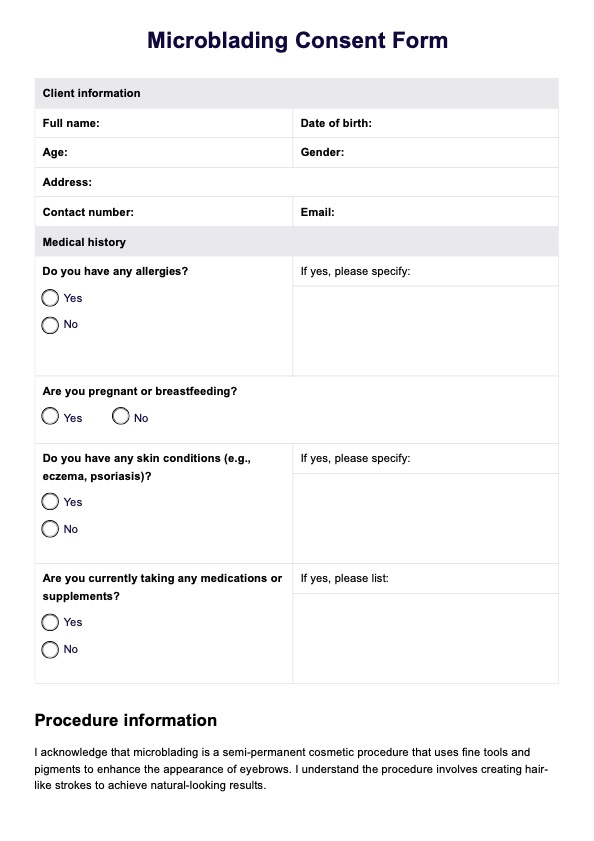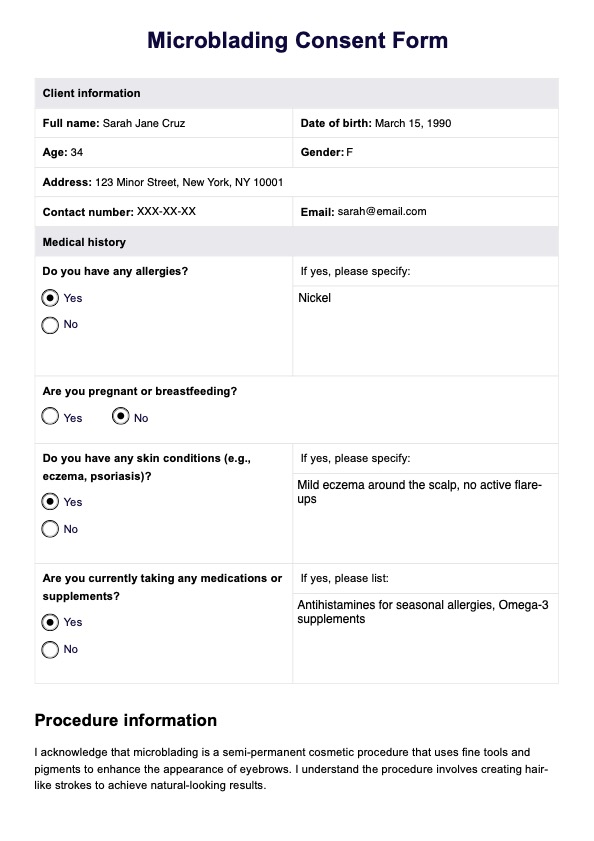Microblading Consent Form
Discover the essential Microblading Consent Form for healthcare professionals and aestheticians, ensuring informed consent and legal compliance.

By Nate Lacson on Jul 15, 2024.


Table of content
What is microblading?
Microblading, a form of permanent makeup, is a semi-permanent cosmetic procedure that involves using a fine, handheld tool to create hair-like strokes in the eyebrow area, mimicking the appearance of natural brows. This technique has gained immense popularity for its ability to enhance the shape, fullness, and definition of eyebrows, providing a natural and long-lasting solution for those seeking to improve their brow aesthetics.
Types of microblading
There are several types of microblading techniques, each offering a unique result:
- Classic Microblading: Involves creating individual hair-like strokes for a natural look.
- Microshading: Also known as powder brows, this technique uses a shading method for a fuller, softer appearance.
- Combo Brows: A combination of microblading and microshading for a more defined look.
- Ombre Brows: Features a gradient effect with lighter fronts and darker tails for a dramatic finish.
Types of pigment
The quality of pigment is crucial in microblading, as it directly impacts the appearance and longevity of the results. There are two main types of pigments used in microblading:
- Organic Pigments: Derived from natural sources such as fruits and vegetables, organic pigments are known for their vibrant and long-lasting colors. They are ideal for creating a natural and rich look for the eyebrows and are less likely to fade quickly.
- Inorganic Pigments: These pigments are made from minerals and contain iron oxide and other metal-containing acids. Inorganic pigments tend to have a softer, more muted color, making them suitable for subtle brow enhancement. However, they can change color over time due to the presence of metal ions.
Both aestheticians and clients need to be aware of the potential risks associated with certain chemicals in microblading pigments and inks:
- Titanium dioxide: Used to lighten pigments, this chemical can lead to an uneven fading effect and a challenging healing process for the eyebrows.
- DMDM hydantoin: This preservative can cause allergic reactions, leading to itching, burning, blistering of the skin, and even an increased risk of skin cancer.
- Isopropyl alcohol: Though less toxic than some other solvents, isopropyl alcohol can still be harmful if absorbed through the skin, ingested, or inhaled.
Encourage clients to ask their beauty technicians about the safety and quality of the pigments used in their microblading procedure.
PDF Template
Example PDF
Microblading Consent Form Template

Microblading Consent Form Example

Microblading health risks
Microblading is a popular cosmetic procedure that can enhance the appearance of eyebrows, but it's important to be aware of potential health risks. While complications are rare when a qualified professional performs the procedure, clients should still understand the possible risks to make informed decisions.
Skin reactions
Before undergoing microblading, it's essential to consider the following risks:
- Infection: The risk of infection can occur if the equipment used is not properly sterilized or if the treated area is not adequately cared for during the healing process.
- Allergic Reactions: Some individuals may experience an allergic reaction to the pigments used in microblading. A patch test can help identify any potential allergies.
- Scarring: Improper technique or aftercare can lead to scarring, which can affect the overall appearance of the brows.
- Granulomas: These small nodules can form around the pigment as a reaction to foreign material in the skin and may require medical treatment.
- Keloids: In some cases, an overgrowth of scar tissue, known as keloids, can occur in response to the microblading procedure.
Pigment-related issues
Pigment-related issues are also important to consider:
- Pigment Migration: Poor technique or low-quality pigments can lead to pigment migration, where the color spreads beyond the intended area.
- Color Changes: Over time, exposure to sunlight and other factors can cause the pigment to change color, potentially leading to unsatisfactory results.
To minimize these risks, ensure that your microblading technicians must all be trained and careful in procedures. Remind clients to follow all aftercare instructions diligently and to attend every recommended follow-up appointment.
Getting consent from your clients
Consent is the voluntary agreement to proceed with a medical or cosmetic procedure after understanding its risks, benefits, and alternatives. Informed consent goes beyond mere agreement; it involves educating the client about the procedure in detail, ensuring they make a well-informed decision.
A consent form is a written document that records the client's informed consent. It is crucial for several reasons:
- It serves as legal proof that the client was fully informed and agreed to the procedure.
- It helps protect both the client and the practitioner in case of any adverse outcomes.
- It ensures that the client has all the necessary information to make an educated decision.
The requirement for consent forms is grounded in law and ethics. Laws vary by region, but generally, healthcare providers are required to obtain informed consent for any treatment. Here's how to effectively obtain consent from your client:
- Educate the client: Provide comprehensive information about the microblading procedure, including what it involves, its benefits, risks, and any alternatives.
- Address questions: Encourage the client to ask questions and express concerns. Answer all queries clearly and thoroughly.
- Review the consent form: Go through the consent form with the client, explaining each section to ensure they understand the details.
- Obtain voluntary agreement: Ensure that the client's decision to consent is made voluntarily, without any coercion.
- Document the consent: Have the client sign the consent form, and keep a copy in their records as a legal document.
By following these steps, you can ensure that your client is well-informed and comfortable with their decision to undergo microblading, which is crucial for a positive experience and outcome.
When to use this template?
The Microblading Consent Form template is a vital tool for ensuring clear communication and legal protection in various situations:
- New clients: For clients who are new to microblading, the consent form provides a structured way to inform them about the procedure, its risks, and aftercare instructions.
- Clients with specific conditions: It's essential to use the consent form for clients with skin conditions, allergies, or other medical conditions that could affect the microblading process.
- Updating client records: Whenever a returning client undergoes another microblading session, reviewing and updating the consent form to reflect any changes in their health or preferences is good practice.
- Legal compliance: In jurisdictions where consent forms are required by law for cosmetic procedures, using this template ensures compliance with legal standards.
By utilizing the Microblading Consent Form template in these scenarios, practitioners can provide a higher level of care, maintain accurate records, and protect both themselves and their clients.
How to use this template?
Using the Microblading Consent Form template is straightforward and involves a few key steps:
Step 1: Prepare the template
Access the latest version of the template directly from the Carepatron app or from the template library. The template is printable, customizable, and shareable, making it easy to tailor to your specific needs and share with your clients.
Step 2: Review and explain
Sit down with your client and review the consent form together. Explain each section, ensuring they understand the procedure, risks, benefits, and aftercare instructions.
Step 3: Complete and sign
Have the client fill in their personal details and any relevant medical history. Address any questions or concerns they may have. Once they fully understand and agree to the procedure, obtain their signature to formalize their informed consent. If the form is sent on the Carepatron app, your client can provide an electronic signature.
Step 4: Store securely
Keep the signed consent form in the client's file for future reference, ensuring it is stored securely as a legal document.
By following these steps, you can ensure that your clients are well-informed and have provided their consent before proceeding with the microblading treatment.
Benefits of using our Microblading Consent Form template
Utilizing our Microblading Consent Form template brings a host of benefits to your practice, ensuring a smoother, more professional, and legally sound microblading process. Here's how you benefit from using our template:
- Enhanced clarity: The template provides a clear and structured format for explaining the microblading procedure, its risks, and aftercare instructions, ensuring that clients are well-informed.
- Legal protection: Having a signed consent form provides legal protection for both the client and the practitioner in case of any adverse outcomes.
- Time-saving: The template streamlines the consent process, saving time and allowing for more focus on the client's needs and the microblading procedure itself.
- Customizability: The template can be easily customized to suit the specific needs of your practice and the preferences of your clients.
- Professionalism: Using a well-designed consent form enhances the professionalism of your service, instilling confidence in your clients.
Best of all, if you got this template from the Carepatron app, you also benefit from all the great features that Carepatron has to offer. Up next, we'll go over those features.






